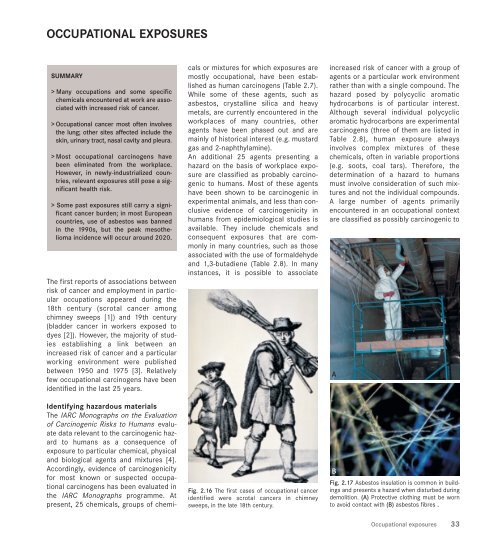world cancer report - iarc
world cancer report - iarc
world cancer report - iarc
You also want an ePaper? Increase the reach of your titles
YUMPU automatically turns print PDFs into web optimized ePapers that Google loves.
OCCUPATIONAL EXPOSURES<br />
SUMMARY<br />
> Many occupations and some specific<br />
chemicals encountered at work are associated<br />
with increased risk of <strong>cancer</strong>.<br />
> Occupational <strong>cancer</strong> most often involves<br />
the lung; other sites affected include the<br />
skin, urinary tract, nasal cavity and pleura.<br />
> Most occupational carcinogens have<br />
been eliminated from the workplace.<br />
However, in newly-industrialized countries,<br />
relevant exposures still pose a significant<br />
health risk.<br />
> Some past exposures still carry a significant<br />
<strong>cancer</strong> burden; in most European<br />
countries, use of asbestos was banned<br />
in the 1990s, but the peak mesothelioma<br />
incidence will occur around 2020.<br />
The first <strong>report</strong>s of associations between<br />
risk of <strong>cancer</strong> and employment in particular<br />
occupations appeared during the<br />
18th century (scrotal <strong>cancer</strong> among<br />
chimney sweeps [1]) and 19th century<br />
(bladder <strong>cancer</strong> in workers exposed to<br />
dyes [2]). However, the majority of studies<br />
establishing a link between an<br />
increased risk of <strong>cancer</strong> and a particular<br />
working environment were published<br />
between 1950 and 1975 [3]. Relatively<br />
few occupational carcinogens have been<br />
identified in the last 25 years.<br />
Identifying hazardous materials<br />
The IARC Monographs on the Evaluation<br />
of Carcinogenic Risks to Humans evaluate<br />
data relevant to the carcinogenic hazard<br />
to humans as a consequence of<br />
exposure to particular chemical, physical<br />
and biological agents and mixtures [4].<br />
Accordingly, evidence of carcinogenicity<br />
for most known or suspected occupational<br />
carcinogens has been evaluated in<br />
the IARC Monographs programme. At<br />
present, 25 chemicals, groups of chemi-<br />
cals or mixtures for which exposures are<br />
mostly occupational, have been established<br />
as human carcinogens (Table 2.7).<br />
While some of these agents, such as<br />
asbestos, crystalline silica and heavy<br />
metals, are currently encountered in the<br />
workplaces of many countries, other<br />
agents have been phased out and are<br />
mainly of historical interest (e.g. mustard<br />
gas and 2-naphthylamine).<br />
An additional 25 agents presenting a<br />
hazard on the basis of workplace exposure<br />
are classified as probably carcinogenic<br />
to humans. Most of these agents<br />
have been shown to be carcinogenic in<br />
experimental animals, and less than conclusive<br />
evidence of carcinogenicity in<br />
humans from epidemiological studies is<br />
available. They include chemicals and<br />
consequent exposures that are commonly<br />
in many countries, such as those<br />
associated with the use of formaldehyde<br />
and 1,3-butadiene (Table 2.8). In many<br />
instances, it is possible to associate<br />
Fig. 2.16 The first cases of occupational <strong>cancer</strong><br />
identified were scrotal <strong>cancer</strong>s in chimney<br />
sweeps, in the late 18th century.<br />
increased risk of <strong>cancer</strong> with a group of<br />
agents or a particular work environment<br />
rather than with a single compound. The<br />
hazard posed by polycyclic aromatic<br />
hydrocarbons is of particular interest.<br />
Although several individual polycyclic<br />
aromatic hydrocarbons are experimental<br />
carcinogens (three of them are listed in<br />
Table 2.8), human exposure always<br />
involves complex mixtures of these<br />
chemicals, often in variable proportions<br />
(e.g. soots, coal tars). Therefore, the<br />
determination of a hazard to humans<br />
must involve consideration of such mixtures<br />
and not the individual compounds.<br />
A large number of agents primarily<br />
encountered in an occupational context<br />
are classified as possibly carcinogenic to<br />
A<br />
B<br />
Fig. 2.17 Asbestos insulation is common in buildings<br />
and presents a hazard when disturbed during<br />
demolition. (A) Protective clothing must be worn<br />
to avoid contact with (B) asbestos fibres .<br />
Occupational exposures 33

















